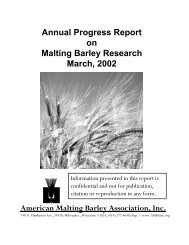Annual Progress Report on Malting Barley Research March, 2007
Annual Progress Report on Malting Barley Research March, 2007
Annual Progress Report on Malting Barley Research March, 2007
Create successful ePaper yourself
Turn your PDF publications into a flip-book with our unique Google optimized e-Paper software.
small grains pathology input to this project involves the oversight of inoculum<br />
preparati<strong>on</strong> during the winter and spring, assisting with summer plot maintenance<br />
including the operati<strong>on</strong> of the mist-irrigati<strong>on</strong> system, and spray applicati<strong>on</strong>s of inoculum<br />
during the summer field seas<strong>on</strong>.<br />
In the 2006 field seas<strong>on</strong> a total of 14,350 rows were screened in breeding nurseries.<br />
The number of field rows evaluated was much the same as in the previous two years.<br />
Field nurseries were c<strong>on</strong>ducted at three locati<strong>on</strong>s; St Paul with 6,800 rows, Morris with<br />
800 rows and Crookst<strong>on</strong> with 6,750 rows. Nurseries at all three locati<strong>on</strong>s were primarily<br />
inoculated and mist-irrigated to promote disease development, although we also<br />
established dryland (without irrigati<strong>on</strong>) nurseries at both St Paul and Crookst<strong>on</strong> to<br />
provide additi<strong>on</strong>al screening under weather c<strong>on</strong>diti<strong>on</strong>s which more closely resemble<br />
those of commercial crops. In 2006 approximately 4000 liters of macroc<strong>on</strong>idial<br />
inoculum (800,000 macroc<strong>on</strong>idia ml -1 ) was produced in our lab and used by five<br />
separate research programs (for barley, wheat and oat research).<br />
Greenhouse Screening Program: During the fall, winter, and spring seas<strong>on</strong>s<br />
greenhouse tests for resistance to Fusarium head blight are c<strong>on</strong>ducted in the<br />
greenhouse. Testing of approximately 250 pots of barley was completed in 2006. The<br />
inoculati<strong>on</strong> of barley plants in the greenhouse is c<strong>on</strong>ducted using an airbrush sprayer to<br />
deliver macroc<strong>on</strong>idial inoculum to <strong>on</strong>e face of the barley spike. Point inoculati<strong>on</strong>s, as<br />
used widely in screening wheat for resistance to FHB, do not differentiate between<br />
resistance and susceptible barley varieties. This spray inoculati<strong>on</strong> technique has<br />
proven useful to detect QTL associated with reacti<strong>on</strong> to deoxynivalenol accumulati<strong>on</strong> in<br />
barley.<br />
<strong>Research</strong> <strong>on</strong> Foliar Diseases – Methodology and Results<br />
This program provides support to the barley breeding program as part of <strong>on</strong>going<br />
breeding efforts to develop improved germplasm with improved disease resistance.<br />
Screening breeding germplasm for resistance to kernel discolorati<strong>on</strong>, leaf rust, loose<br />
smut, net blotch, powdery mildew, and spot blotch are c<strong>on</strong>ducted <strong>on</strong> an <strong>on</strong>going basis<br />
with the barley breeding program.<br />
In 2006 evaluati<strong>on</strong>s were c<strong>on</strong>ducted to identify resistant germplasm in breeding<br />
populati<strong>on</strong>s following natural infecti<strong>on</strong>s of leaf spot diseases at the Northwest <strong>Research</strong><br />
and Outreach Center, Crookst<strong>on</strong> and the West Central <strong>Research</strong> and Outreach Center,<br />
Morris.<br />
In 2006, we established a net blotch nursery of approximately 600 rows at Stephen.<br />
However, due to the extremely dry c<strong>on</strong>diti<strong>on</strong>s in 2006, little disease development was<br />
observed. Nevertheless, straw infected with the net blotch pathogen was collected by<br />
for inoculati<strong>on</strong> of the nursery in <strong>2007</strong>. Despite two disappointing years (the 2005 trial<br />
was lost to flooding) we remain c<strong>on</strong>fident that future screening nurseries in Stephen will<br />
be successful. The <strong>on</strong>ly two nurseries we have lost in over ten years have been these<br />
29
















